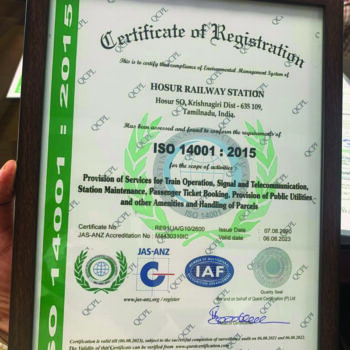NEW DELHI/CHENNAI, JUN 4
Indian Railways is working on “mission mode’’ to become the largest Green Railways in the world and is moving towards becoming a “net zero carbon emitter” before 2030, says a senior railway official on Friday.
In a statement on the eve of World Environment Day, the railways said that the network’s electrification, which is environment friendly and reduces pollution, has increased nearly ten times since 2014.
“The Indian Railways (IR) is working in mission mode to become the largest Green Railways in the world and is moving towards becoming a ”net zero carbon emitter” before 2030.
As part of this measure and to achieve the desired the goal, IR in general and Southern Railway in particular are taking slew of measures on energy conservation.
Head on Generation (HOG)
IR has introduced Head on Generation (HOG) system, whereby electrical power is fed to the coaches, for lighting and fans, directly from the Over Head Equipment (OHE) through the Locomotive. This would eliminate the need for separate power car coaches and improves efficiency. As many as 1,280 trains have been equipped with the HOG system in Indian Railways. This will facilitate reduction in Carbon footprint by 31,88,929 Ton per annum and saving in fuel costs to the tune of Rs 2,300 crore due to elimination of power cars.
Southern Railway saves Rs 100 crore annually
In Southern Railway Zone, 27 pairs of trains were run with HOG compliant rakes in 2020-21. A total of 51 pairs of trains are running now with HOG locos which is yielding Southern Railway an annual savings of Rs100 crores.
Reducing Pollution by Shifting from Diesel Locos to Electric Locos with increasing electrification, Indian Railways has stepped up the production of electric locomotives significantly in the last few years.
According to statistics provided by Southern Railway, it had produced 264 Electric Locos during 2013-14, 605 numbers during 2018-19, 784 Locos in 2019-20, 721 in 2020-21 and planned to produce 905 Locos during the current financial year (2021-2022).
IR achieved around 77% GTKM share of Electric Locos
Reduced use of diesel locomotives for train operation has resulted in increased share of electric Gross Ton Km (GTKM) (around 77%) as compared to 65.4% during 2013-14 in haulage of freight trains and huge savings in diesel consumption, a release said.
In Southern Railway during the year 2020-21, 27 pairs of trains were taken over from other railway in electric traction which has resulted in releasing 22 diesel locos. This has reduced the transit time required for loco change from electric to diesel traction and vice versa.

New and Better Locos with Higher Energy efficiency Indian Railways has awarded a contract for supply of 800 electric locomotives with 12,000 HP Insulated Gate Bipolar transistor based three phase propulsion technology. These locomotives are energy efficient and have digital tracking features. 106 of these have been inducted on IR to haul heavier freight trains at higher speeds. At full load, its efficiency is 87%. It has been decided to produce only 3 phase propulsion fitted electric locomotives in all three production units of Indian Railways, the release further added.
⇐ Over 600 railway stations have been certified for implementation of the Environment Management System to ISO:14001 in the last two years. A total of 718 stations have been identified for ISO:14001 certification.
“The Indian Railways has incorporated climate change features in its own risk assessments and disaster management protocols. As an organisation ready to manage the risks, and ask the right questions about its assets, routes and investments. Top management in IR”s many public sectors have been communicating with stakeholders for a shared understanding, needed for long-term health and sustainability of the organisations they lead,” the statement said.
It also said that the Environment Sustainability Report published by the IR and subsidiary units each year sets up a framework document defining strategies and focus points in the context of climate change, the issues at stake, and steps for dealing with them.
“It helps railways to support government commitments such as the Paris agreement on climate change, the UN Sustainable Development Goals and National Disaster Management Plans,” it said.












